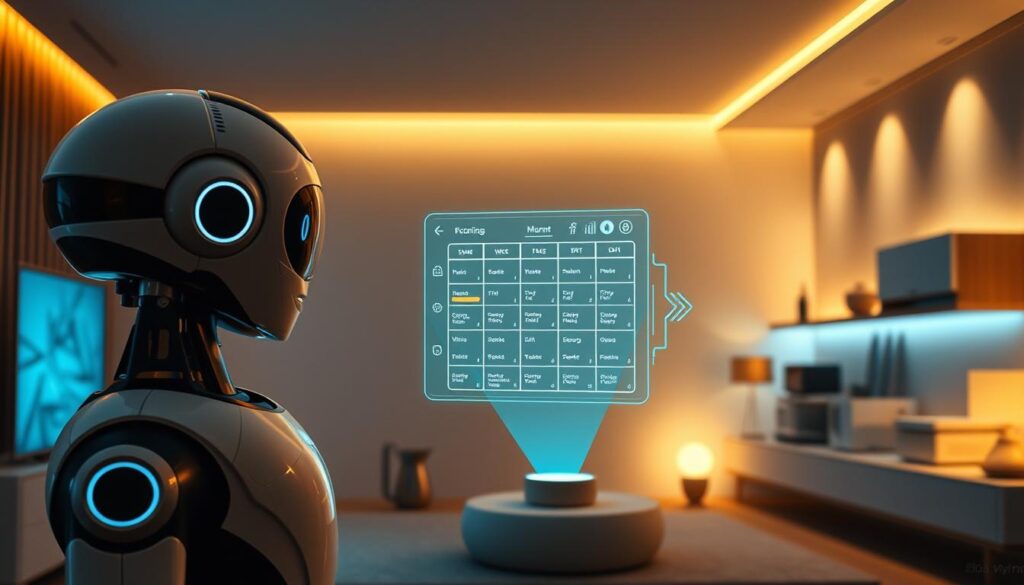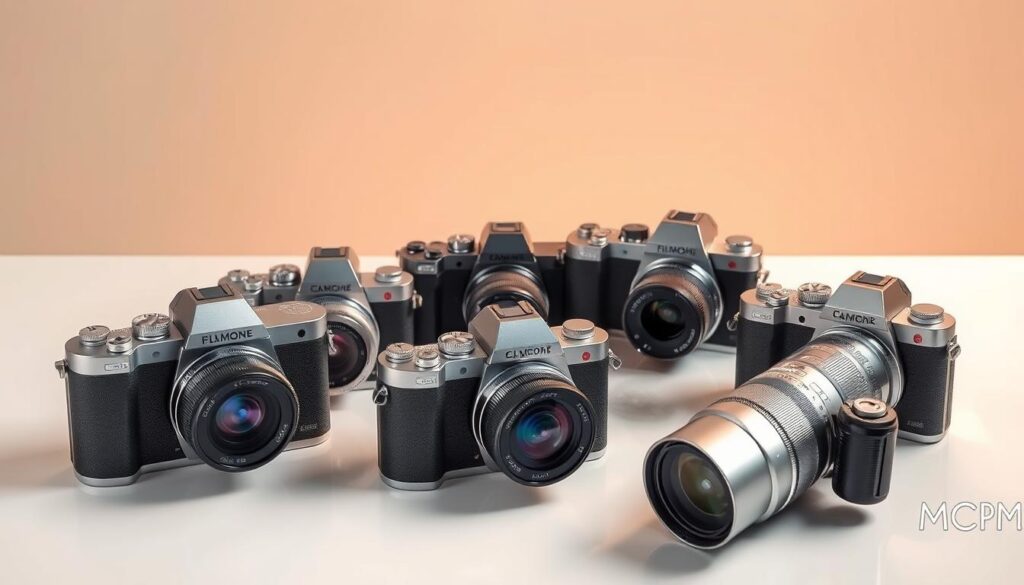The world is rapidly adopting AI-powered gadgets, with over 100 million smart home devices sold in the United States alone last year. As we continue to integrate technology into our daily lives, the debate between smart speakers and smart displays has gained significant attention.
Both devices offer unique features, from voice control and smart home integration to visual interfaces and multimedia capabilities. The decision between these two types of devices depends on various factors, including functionality, price, and personal preferences.

As we explore the differences between these AI gadgets, we’ll help you make an informed decision about which one is right for you.
Key Takeaways
- Understand the core features of smart speakers and smart displays.
- Learn about the key differences between these AI-powered gadgets.
- Discover how to choose the best device based on your needs and preferences.
- Explore the impact of AI technology on smart home devices.
- Get insights into the future of smart speakers and smart displays.
Understanding the Basics: What Sets These AI Gadgets Apart
The distinction between smart speakers and smart displays is not just about the presence of a screen; it’s about the overall user experience they provide.
At the heart of this distinction are two different approaches to interacting with AI gadgets. Smart speakers rely heavily on voice commands, while smart displays add a visual element to this voice-controlled experience.
Smart Speakers: Audio-Focused Assistants
Smart speakers are designed to be audio-focused assistants, providing users with a hands-free way to control their smart home devices, play music, and access information. These devices are equipped with advanced voice recognition technology, allowing them to understand and respond to a wide range of voice commands.
Key benefits of smart speakers include:
- Convenience: Control your smart home devices without needing to physically interact with them.
- Multi-room audio: Enjoy synchronized music playback across multiple rooms.
- Information access: Get news updates, weather forecasts, and more with just a voice command.
As “The Verge” notes, “Smart speakers have revolutionized the way we interact with technology, making it more accessible and convenient than ever before.”
Smart Displays: Adding Visual Elements to Voice Control
Smart displays take the voice-controlled experience of smart speakers and add a visual element, enhancing the overall user experience. With a screen, users can not only hear information but also see it, making tasks like watching recipes, checking calendars, and controlling smart home devices more intuitive.
Key benefits of smart displays include:
- Visual feedback: See the information you’re requesting, making it easier to understand and interact with.
- Enhanced control: Use the screen to control smart home devices, watch videos, and more.
- Additional functionality: Enjoy features like video calling, recipe tutorials, and more.
“The addition of a screen to a smart speaker can significantly enhance the user experience, providing a more interactive and engaging way to control smart home devices and access information.”
— Expert Review
Smart Speakers vs Smart Displays: Which AI Gadget Should You Choose
Understanding the differences between smart speakers and smart displays is crucial for making an informed decision. Both devices have their unique features and functionalities that cater to different user needs.
Functionality and Feature Comparison
Smart speakers are primarily audio-focused, offering high-quality sound and voice control through virtual assistants like Alexa and Google Assistant. They are ideal for playing music, setting alarms, and controlling other smart devices in your home.
Smart displays, on the other hand, add a visual element to the voice control experience. Devices like the Google Nest Hub and Amazon Echo Show offer touchscreens that can display recipes, show videos, and provide visual feedback. This makes them more versatile for tasks that require visual interaction.
When comparing the functionalities of smart speakers and smart displays, it’s essential to consider your specific needs. If you prioritize audio quality and use your device mainly for listening to music or podcasts, a smart speaker might be the better choice. However, if you want a device that can also display information or show videos, a smart display is more suitable.
Price Point Analysis: Budget Considerations
The pricing of smart speakers and smart displays varies significantly across different models and brands. Generally, smart speakers are more affordable, with prices starting from around $50 for basic models like the Amazon Echo Dot.
Smart displays, due to their additional visual capabilities, tend to be pricier. The Google Nest Hub, for example, starts at around $100, while higher-end models like the Amazon Echo Show 10 can cost upwards of $250.
| Device | Price Range | Key Features |
|---|---|---|
| Amazon Echo | $50-$150 | High-quality audio, Alexa integration |
| Google Nest Hub | $100-$200 | Touchscreen display, Google Assistant |
| Amazon Echo Show | $100-$250 | Display, Alexa integration, camera |
Space Requirements and Aesthetic Integration
The physical design and space requirements of smart speakers and smart displays are another critical consideration. Smart speakers are generally compact and can fit into most home environments without being obtrusive.
Smart displays, while also designed to be sleek and modern, require more space due to their screens. They can be a focal point in a room, such as a kitchen or living room, and can be mounted on walls or placed on countertops.
When choosing between a smart speaker and a smart display, consider the layout of your home and where you plan to place the device. This will help you decide which type of device will integrate best into your living space.
Popular Models Face-Off: Top Contenders in Each Category
The battle for supremacy in the smart home ecosystem is heating up, with smart speakers and displays vying for consumer attention. In this section, we’ll pit the top models against each other, examining their unique features and capabilities to help you make an informed decision.
Leading Smart Speakers: Amazon Echo, Google Nest Audio, and Apple HomePod
Smart speakers have revolutionized the way we interact with technology, offering a hands-free experience with voice assistants at the helm. Let’s dive into the specifics of the leading models.
Key Features and Voice Assistant Capabilities
The Amazon Echo boasts Alexa, a virtual voice assistant capable of controlling smart home devices, playing music, and more. The Google Nest Audio offers Google Assistant, which excels in providing personalized recommendations and integrating with other Google services. Meanwhile, the Apple HomePod features Siri, known for its seamless integration with Apple devices and services.
- Amazon Echo: Extensive smart home control, wide compatibility
- Google Nest Audio: Superior personalized recommendations, Google service integration
- Apple HomePod: Seamless Apple ecosystem integration, high-quality audio
Sound Quality and Performance
When it comes to sound quality, these smart speakers deliver impressive performance. The Apple HomePod is renowned for its high-fidelity audio, while the Google Nest Audio offers clear and balanced sound. The Amazon Echo also provides good sound quality, though it may not match its competitors in terms of fidelity.
- Apple HomePod: High-fidelity audio
- Google Nest Audio: Clear and balanced sound
- Amazon Echo: Good overall sound quality
Top Smart Displays: Google Nest Hub, Amazon Echo Show, and Facebook Portal
Smart displays take the functionality of smart speakers to the next level by adding a visual element. Let’s examine the top contenders in this category.
Screen Quality and Visual Features
The Google Nest Hub and Amazon Echo Show both offer vibrant screens with intuitive interfaces, making it easy to control smart home devices, watch videos, and more. The Facebook Portal is designed with video calling in mind, featuring a high-quality camera and screen.
- Google Nest Hub: Vibrant screen, intuitive interface
- Amazon Echo Show: Versatile display, easy smart home control
- Facebook Portal: High-quality camera, ideal for video calls
Smart Home Control Capabilities
All three devices offer robust smart home control capabilities, allowing users to manage their devices with ease. The Google Nest Hub and Amazon Echo Show are particularly strong in this regard, with compatibility with a wide range of smart devices.
By comparing these top models, you can better understand which device best fits your needs and preferences, whether you’re looking for superior sound quality, advanced smart home control, or enhanced visual features.
Conclusion: Making the Right Choice for Your Smart Home
Choosing between a smart speaker and a smart display ultimately depends on your specific needs and preferences. As smart home technology trends continue to evolve, understanding the differences between these AI gadgets is crucial for creating a seamless and integrated home experience.
Smart speakers, like Amazon Echo and Google Nest Audio, offer a more straightforward audio-focused experience, while smart displays, such as Google Nest Hub and Amazon Echo Show, add a visual element to voice control, enhancing the overall interaction.
As you consider your smart home setup, think about how you plan to use these devices. If you’re looking for a simple, voice-controlled assistant, a smart speaker might be the way to go. However, if you want to integrate visual elements, such as watching videos or controlling smart home devices with a touchscreen, a smart display is likely a better fit.
By considering your individual needs and staying informed about the latest smart home technology trends, you can make an informed decision and create a smart home ecosystem that suits your lifestyle.
FAQ
What is the main difference between smart speakers and smart displays?
Smart speakers are primarily audio-focused assistants that rely on voice commands, while smart displays add a visual element to voice control, providing a more interactive experience.
Which is better for controlling smart home devices: Google Nest Hub or Amazon Echo?
Both devices can control smart home devices, but Google Nest Hub offers a more comprehensive visual interface, making it easier to manage multiple devices. Amazon Echo, on the other hand, relies on voice commands.
How do I choose between a smart speaker and a smart display for my home?
Consider your specific needs and preferences. If you prioritize audio quality and voice control, a smart speaker might be the better choice. If you prefer a more interactive experience with visual elements, a smart display is the way to go.
What are some popular smart speaker models, and how do they compare?
Popular smart speaker models include Amazon Echo, Google Nest Audio, and Apple HomePod. They differ in terms of voice assistant capabilities, sound quality, and compatibility with other smart devices.
Are smart displays worth the extra cost compared to smart speakers?
Smart displays offer additional features like visual interfaces and screen-based interactions, which may be worth the extra cost for those who value a more interactive smart home experience.
Can I use a smart speaker or smart display with my existing smart home devices?
Most smart speakers and smart displays are compatible with a wide range of smart home devices. Check the device’s specifications to ensure compatibility with your existing smart home ecosystem.
What are the current smart home technology trends that I should be aware of?
Current trends include the integration of AI-powered voice assistants, increased focus on smart home security, and the development of more advanced smart display technologies.
How do voice assistants like Alexa and Google Assistant compare?
Alexa and Google Assistant are both popular voice assistants with different strengths and weaknesses. Alexa is known for its compatibility with a wide range of smart devices, while Google Assistant offers more advanced AI capabilities and integration with Google services.


